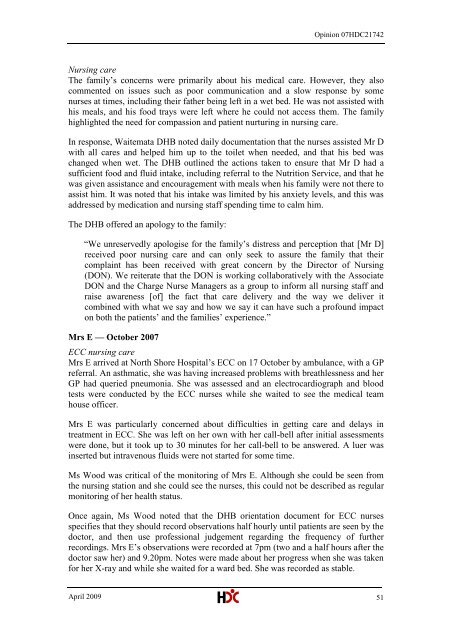North Shore Hospital report - New Zealand Doctor
North Shore Hospital report - New Zealand Doctor
North Shore Hospital report - New Zealand Doctor
Create successful ePaper yourself
Turn your PDF publications into a flip-book with our unique Google optimized e-Paper software.
Opinion 07HDC21742Nursing careThe family‘s concerns were primarily about his medical care. However, they alsocommented on issues such as poor communication and a slow response by somenurses at times, including their father being left in a wet bed. He was not assisted withhis meals, and his food trays were left where he could not access them. The familyhighlighted the need for compassion and patient nurturing in nursing care.In response, Waitemata DHB noted daily documentation that the nurses assisted Mr Dwith all cares and helped him up to the toilet when needed, and that his bed waschanged when wet. The DHB outlined the actions taken to ensure that Mr D had asufficient food and fluid intake, including referral to the Nutrition Service, and that hewas given assistance and encouragement with meals when his family were not there toassist him. It was noted that his intake was limited by his anxiety levels, and this wasaddressed by medication and nursing staff spending time to calm him.The DHB offered an apology to the family:―We unreservedly apologise for the family‘s distress and perception that [Mr D]received poor nursing care and can only seek to assure the family that theircomplaint has been received with great concern by the Director of Nursing(DON). We reiterate that the DON is working collaboratively with the AssociateDON and the Charge Nurse Managers as a group to inform all nursing staff andraise awareness [of] the fact that care delivery and the way we deliver itcombined with what we say and how we say it can have such a profound impacton both the patients‘ and the families‘ experience.‖Mrs E — October 2007ECC nursing careMrs E arrived at <strong>North</strong> <strong>Shore</strong> <strong>Hospital</strong>‘s ECC on 17 October by ambulance, with a GPreferral. An asthmatic, she was having increased problems with breathlessness and herGP had queried pneumonia. She was assessed and an electrocardiograph and bloodtests were conducted by the ECC nurses while she waited to see the medical teamhouse officer.Mrs E was particularly concerned about difficulties in getting care and delays intreatment in ECC. She was left on her own with her call-bell after initial assessmentswere done, but it took up to 30 minutes for her call-bell to be answered. A luer wasinserted but intravenous fluids were not started for some time.Ms Wood was critical of the monitoring of Mrs E. Although she could be seen fromthe nursing station and she could see the nurses, this could not be described as regularmonitoring of her health status.Once again, Ms Wood noted that the DHB orientation document for ECC nursesspecifies that they should record observations half hourly until patients are seen by thedoctor, and then use professional judgement regarding the frequency of furtherrecordings. Mrs E‘s observations were recorded at 7pm (two and a half hours after thedoctor saw her) and 9.20pm. Notes were made about her progress when she was takenfor her X-ray and while she waited for a ward bed. She was recorded as stable.April 2009 51
















